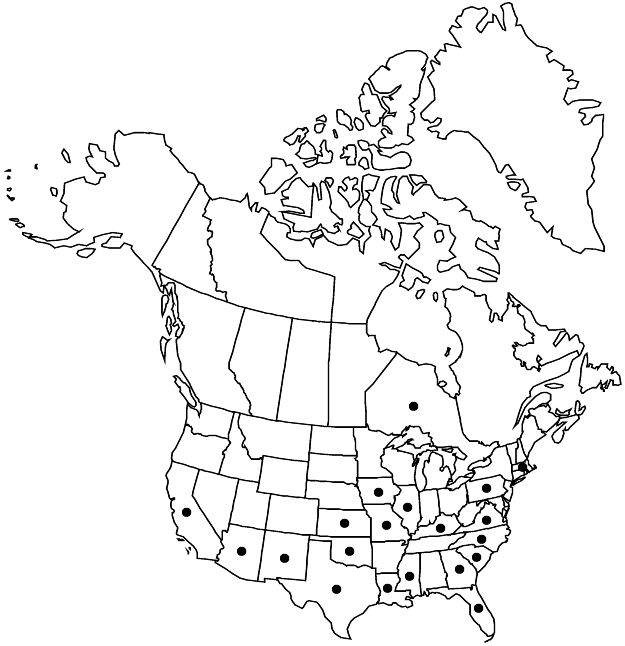Difference between revisions of "Anoda cristata"
Linnaea 11: 210. 1837.
FNA>Volume Importer |
FNA>Volume Importer |
||
| Line 15: | Line 15: | ||
|name=Sida cristata | |name=Sida cristata | ||
|authority=Linnaeus | |authority=Linnaeus | ||
| + | |rank=species | ||
|publication_title=Sp. Pl. | |publication_title=Sp. Pl. | ||
|publication_place=2: 685. 1753 | |publication_place=2: 685. 1753 | ||
| Line 21: | Line 22: | ||
|name=Anoda arizonica | |name=Anoda arizonica | ||
|authority=A. Gray | |authority=A. Gray | ||
| + | |rank=species | ||
}} {{Treatment/ID/Synonym | }} {{Treatment/ID/Synonym | ||
|name=A. hastata | |name=A. hastata | ||
|authority=Cavanilles | |authority=Cavanilles | ||
| + | |rank=species | ||
}} {{Treatment/ID/Synonym | }} {{Treatment/ID/Synonym | ||
|name=A. triangularis | |name=A. triangularis | ||
|authority=(Willdenow) de Candolle | |authority=(Willdenow) de Candolle | ||
| + | |rank=species | ||
}} | }} | ||
|hierarchy=Malvaceae;Malvaceae subfam. Malvoideae;Anoda;Anoda cristata | |hierarchy=Malvaceae;Malvaceae subfam. Malvoideae;Anoda;Anoda cristata | ||
| Line 51: | Line 55: | ||
-->{{#Taxon: | -->{{#Taxon: | ||
name=Anoda cristata | name=Anoda cristata | ||
| − | |||
|authority=(Linnaeus) Schlechtendal | |authority=(Linnaeus) Schlechtendal | ||
|rank=species | |rank=species | ||
| Line 66: | Line 69: | ||
|publication year=1837 | |publication year=1837 | ||
|special status=Weedy | |special status=Weedy | ||
| − | |source xml=https://jpend@bitbucket.org/aafc-mbb/fna-data-curation.git/src/ | + | |source xml=https://jpend@bitbucket.org/aafc-mbb/fna-data-curation.git/src/f50eec43f223ca0e34566be0b046453a0960e173/coarse_grained_fna_xml/V6/V6_419.xml |
|subfamily=Malvaceae subfam. Malvoideae | |subfamily=Malvaceae subfam. Malvoideae | ||
|genus=Anoda | |genus=Anoda | ||
Revision as of 22:04, 16 December 2019
Herbs, to 1 m, usually much shorter (quite variable). Stems suberect to decumbent, with patent or retrorse, simple hairs, hairs 1 mm. Leaves: petiole 1/2 times to equaling blade, hispid; blade concolorous, often with purple blotch along midvein, ovate, triangular, hastate, or sometimes palmately lobed, mostly 3–9 cm, membranous, base cordate, wide-rounded, or truncate, margins crenate to subentire, apex acute, surfaces sparsely hairy, hairs mostly simple, appressed, 1 mm. Inflorescences solitary flowers. Pedicels 4–12 cm, often exceeding leaf. Flowers: calyx 5–10 mm, accrescent to 12–20 mm, lobes without dark midrib, apex acute, hispid; petals purplish or lavender, rarely white, drying purplish, sometimes bluish, 8–26(–30) mm; staminal column hairy; style 10–19-branched; stigmas glabrous. Schizocarps 8–11 mm diam. (excluding spines), densely hispid; mericarps 10–19, with dorsal spur 1.5–4 mm. Seeds with or without enclosing endocarp. 2n = 30, 60, 90.
Phenology: Flowering summer–fall.
Habitat: Usually weedy in disturbed areas, fence rows, agricultural fields
Elevation: 0–2300 m
Distribution

Ont., Ariz., Calif., Fla., Ga., Ill., Iowa, Kans., Ky., La., Mass., Miss., Mo., N.Mex., N.C., Okla., Pa., S.C., Tex., Va., Mexico, West Indies, Central America, South America, introduced in Australia.
Discussion
Anoda cristata appears to be increasing its range in North America and elsewhere. It is quite variable, with either a decumbent to suberect habit and with varied flower sizes. The weedy form has generally small flowers while those to the south in Mexico have showy larger flowers even used in floral arrangements.
Selected References
None.